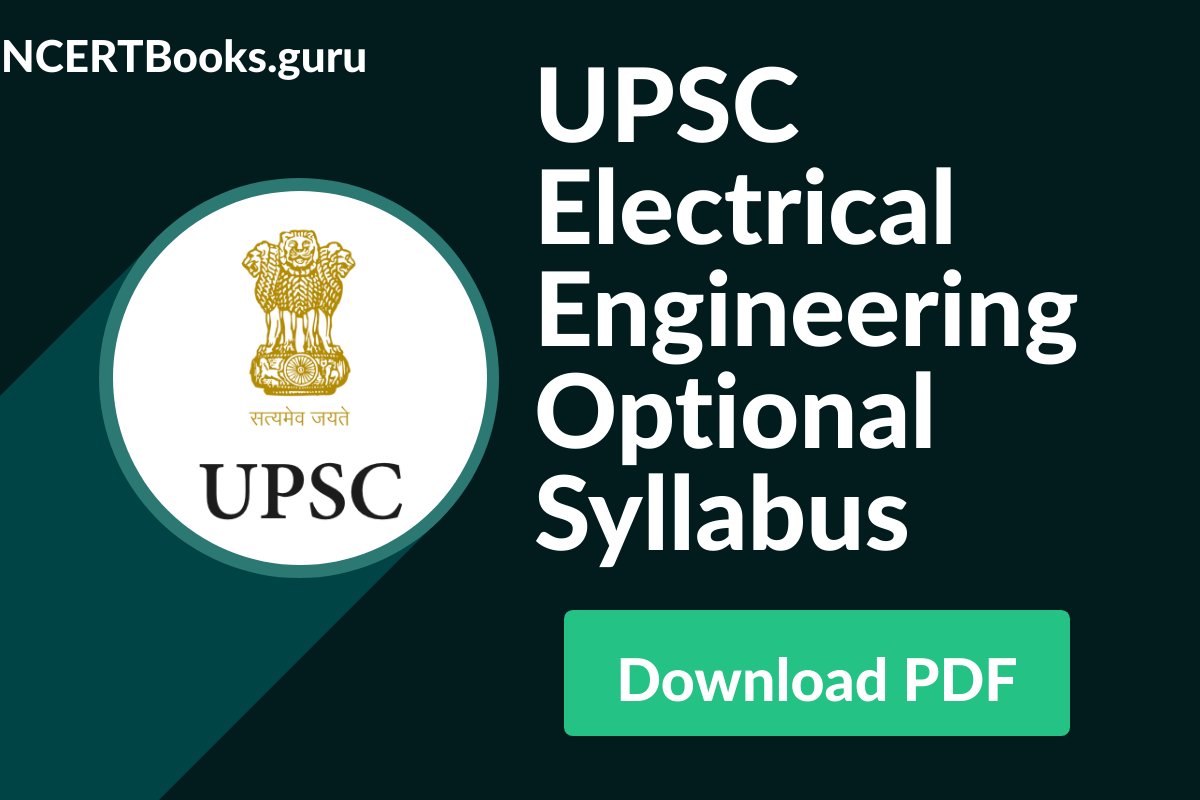UPSC Electrical Engineering Syllabus: UPSC Civil Service Examination includes Electrical Engineering as an Optional Subject. Electrical Engineering is a popular optional subject due to its rational nature and scoring ability. Students willing to appear in the Electrical Engineering Optional Paper are suggested to follow the syllabus accordingly. By doing so, you can score max. marks in your UPSC Electrical Engineering IAS Optional Paper.
To help such aspirants we have provided UPSC Electrical Engineering Optional Syllabus PDF in the coming modules. You can tap on the link to download the Electrical Engineering Syllabus for UPSC Prelims and Mains.
UPSC CSE Electrical Engineering Optional Syllabus PDF
UPSC Mains Electrical Engineering Optional Subject contains two papers in Civil Service Examination. Each Paper is for 250 Marks and comprises a total of 500 Marks. Many people consider this optional paper for IAS Mains Exam as a part of it overlaps with General Studies Paper – I. You can check out the UPSC CSE Electrical Engineering Syllabus for Mains by referring below.
UPSC Mains Electrical Engineering Syllabus PAPER – I
-
Circuit Theory:
Circuit components; network graphs; KCL, KVL; circuit analysis methods: nodal analysis, mesh analysis; basic network theorems and applications; transient analysis: RL, RC and RLC circuits; sinusoidal steady state analysis; resonant circuits; coupled circuits; balanced 3-phase circuits; Two-port networks.
2. Signals & Systems:
Representation of continuous–time and discrete-time signals & systems; LTI systems; convolution; impulse response; time-domain analysis of LTI systems based on convolution and differential/difference equations. Fourier transform, Laplace transform, Z-transform, Transfer function. Sampling and recovery of signals DFT, FFT Processing of analog signals through discrete-time systems.
3. E.M. Theory:
Maxwell’s equations, wave propagation in bounded media. Boundary conditions, reflection, and refraction of plane waves. Transmission line: traveling and standing waves, impedance matching, Smith chart.
4. Analog Electronics:
Characteristics and equivalent circuits (large and small-signal) of Diode, BJT, JFET, and MOSFET. Diode circuits: clipping, clamping, rectifier. Biasing and bias stability. FET amplifiers. Current mirror; Amplifiers: single and multi-stage, differential, operational, feedback and power. Analysis of amplifiers; frequency response of amplifiers. OPAMP circuits. Filters; sinusoidal oscillators: a criterion for oscillation; single-transistor and OPAMP configurations. Function generators and wave-shaping circuits. Linear and switching power supplies.
5. Digital Electronics:
Boolean algebra; minimization of Boolean functions; logic gates; digital IC families (DTL, TTL, ECL, MOS, CMOS). Combinational circuits: arithmetic circuits, code converters, multiplexers, and decoders. Sequential circuits: latches and flip-flops, counters and shift-registers. Comparators, timers, multi-vibrators. Sample and hold circuits, ADCs and DACs. Semiconductor memories. Logic implementation using programmable devices (ROM, PLA, FPGA).
6. Energy Conversion:
Principles of electromechanical energy conversion: Torque and emf in rotating machines. DC machines: characteristics and performance analysis; starting and speed control of motors; Transformers: principles of operation and analysis; regulation, efficiency; 3-phase transformers. 3-phase induction machines and synchronous machines: characteristics and performance analysis; speed control.
7. Power Electronics and Electric Drives:
Semiconductor power devices: diode, transistor, thyristor, triac, GTO and MOSFET–static characteristics and principles of operation; triggering circuits; phase control rectifiers; bridge converters: fully-controlled and half-controlled; principles of thyristor choppers and inverters; DC-DC converters; Switch mode inverter; basic concepts of speed control of DC and AC Motor drive applications of variable-speed drives.
8. Analog Communication:
Random variables: continuous, discrete; probability, probability functions. Statistical averages; probability models; Random signals and noise: white noise, noise equivalent bandwidth; a signal transmission with noise; signal to noise ratio. Linear CW modulation: Amplitude modulation: DSB, DSB-SC, and SSB. Modulators and Demodulators; Phase and Frequency modulation: PM & FM signals; narrowband FM; generation & detection of FM and PM, Deemphasis, Preemphasis. CW modulation system: Superheterodyne receivers, AM receivers, communication receivers, FM receivers, phase locked loop, SSB receiver Signal to noise ratio calculation for AM and FM receivers.
UPSC Mains Electrical Engineering Syllabus PAPER – II
1. Control Systems:
Elements of control systems; block-diagram representation; open-loop & closed-loop systems; principles and applications of feed-back. Control system components. LTI systems: time-domain and transform-domain analysis. Stability: Routh Hurwitz criterion, root-loci, Bode plots and polar plots, Nyquist’s criterion; Design of lead-lad compensators. Proportional, PI, PID controllers. State-variable representation and analysis of control systems.
2. Microprocessors and Microcomputers:
PC organization; CPU, instruction set, register set, timing diagram, programming, interrupts memory interfacing, I/O interfacing, programmable peripheral devices.
3. Measurement and Instrumentation:
Error analysis; measurement of current, voltage, power, energy, power factor, resistance, inductance, capacitance, and frequency; bridge measurement. Signal conditioning circuit; Electronic measuring instruments: multimeter, CRO, digital voltmeter, frequency counter, Q-meter, spectrum- analyzer, distortion meter. Transducers: thermocouple, thermistor, LVDT, strain-gauge, piezo-electric crystal.
4. Power Systems: Analysis and Control:
Steady-state performance of overhead transmission lines and cables; principles of active and reactive power transfer and distribution; per-unit quantities; bus admittance and impedance matrices; load flow; voltage control and power factor correction; economic operation; symmetrical components, analysis of symmetrical and unsymmetrical faults. The concept of system stability: swing curves and equal area criterion. Static VAR system. Basic concepts of HVDC transmission.
5. Power System Protection:
Principles of overcurrent, differential and distance protection. The concept of solid state relays. Circuit breakers. Computer-aided protection: Introduction; line bus, generator, transformer protection; numeric relays and application of DSP to protection.
6. Digital Communication:
Pulse code modulation (PCM), differential pulse code modulation (DPCM), delta modulation (DM), Digital modulation and demodulation schemes: amplitude, phase, and frequency keying schemes (ASK, PSK, FSK). Error control coding: error detection and correction, linear block codes, convolution codes. Information measure and source coding. Data networks, 7-layer architecture.
Summary
We wish the information shared above regarding UPSC Electrical Engineering Optional Syllabus has been helpful. If you have any other queries do drop us a comment and we will help you at the earliest possible. Stay in touch with our site for more latest updates on this.
